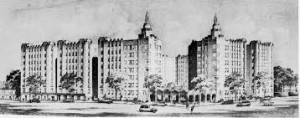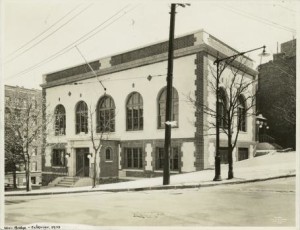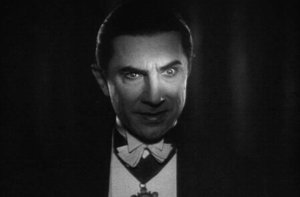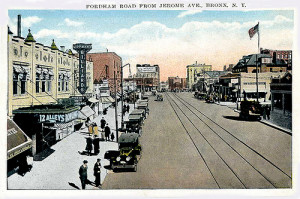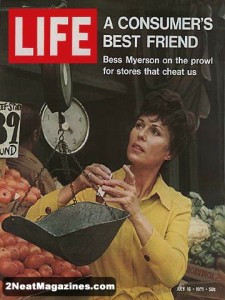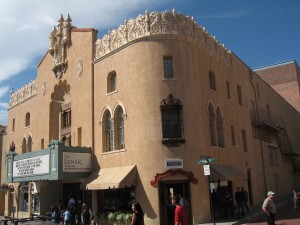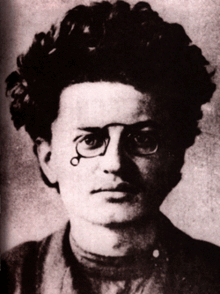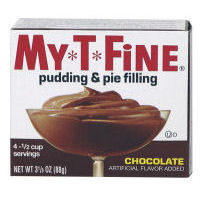HG’s late Mom was a short, hefty woman with a big bosom and an ample bottom. Her marriage to HG’s father was not ideal but they remained married for more than a half century. For immigrant Jews of her generation divorce was non-existent. Chaika (later anglicized to “Ida”) Kopkind, was born in Plestyanitz, a “shtetl” (a Jewish village) in the Minsk province of Belorussia. She was one of three sisters in a family of seven children. Ida, her sister Feigel (“Fanny”) and brother Shmuel (“Samuel”) emigrated to the United States in the early 1900’s. Some of the family died in the pogroms and disruptions following the Russian revolution and the ensuing civil war. The rest were murdered by the Nazis during World War Two. There is no trace of her family left in Russia. (HG’s father’s family, the Freimann family [later anglicized to “Freeman”] fared better. A few members survived including a very old man who recalled HG’s father by his boyhood nickname, “Grisha”.) Ida loved the lively Lower East Side of New York where she lived in a tenement with another immigrant young woman, Maryasha (“Marie”). From her earliest childhood, Ida was nimble with a needle and thread (later a sewing machine). She found employment as a sewing machine “operator” in a clothing factory and her speed and skill gave her a reasonable income doing piece work. (Some of her unlucky friends died in the tragic Triangle Shirtwaist Factory fire, an event that galvanized the Jewish immigrants and led to the unionization of the garment industry). When Ida married Harry Freeman, a skilled cutter in a woman’s coat factory, the young couple moved away from the teeming Lower East Side to the healthier neighborhoods of The Bronx. And, that’s where they raised a family and lived for the great majority of their lives. HG’s Mom was a master of household skills. She had the powerful energy needed in those days of low incomes and no labor saving devices. The HG home was always surgically clean. Laundry was done by hand and dried on clothes lines. Socks were darned and clothing rips were repaired. Mom made shirts, dresses, night gowns on her busy Singer Sewing Machine as well as curtains, table cloths, slip covers, bed covers, etc. She prepared robust food for the HG family of five. The cuisine was Eastern European/Jewish Great stuffed cabbage and chopped liver. Incomparable gefilte fish. Borscht. Schav. Chicken soup with matzo balls. Brisket and gravy.The best blintzes ever. Stuffed derma (a chicken neck stuffed with matzo meal, onions, garlic and spices). Knaidlach (hefty matzo meal dumplings). Mom pickled herring, made her own noodles, baked apple pies, honey cake, rugelach. Ginger and honey glazed pastries were little HG’s favorite. The only vegetable HG recalls was a carrot dish called “tzimmes”. (carrot shavings were baked in a casserole with honey, ginger and cinnamon). Sorry, there were other vegetables. So terrible, HG has blanked them from memory (almost). A big bargain at a local supermarket were “mystery” cans. These were canned foods that had been knocked about and lost their identifying labels. They cost pennies. Mom believed she had a secret talent. She would shake the cans. From the sound she would determine if they contained dessert choices–canned peaches, plums, cherries, prunes. She was often correct but often erred. That meant she opened a can at dessert time. Unfortunately, it might contain brussels sprouts or lima beans. Depression era. Waste not. Want not. The family ate these cold vegetables for dessert. Mom rendered lots of chicken fat and the flavorful stuff played a big role in her cooking. There was a brief, unhappy period when Mom served “American health” food. She was influenced by a radio program, “You Are What You Eat,” hosted by nutrition expert Dr. Victor Lindlahr. Fortunately, under pressure from family protests, the good chicken fat cuisine resumed. Ida did not shower little HG with praise. Mrs. Brownstein, HG’s first grade teacher, told Mom at an obligatory school visit, that HG was a brilliant, gifted child. Mom’s response: “So, if you’re so smart you should help out around the house. And, you should learn to tie your shoelaces so you don’t trip.” Later, when HG was 11, the young fellow competed in the Americana Quiz, a history contest held in New York’s elementary schools. HG was judged best in The Bronx so was eligible to compete for The Best In New York Prize with four other young contenders, one each from Staten Island, Queens, Manhattan and Brooklyn. The event was held in the studio of WNYC, the New York City radio station and hosted by the city’s colorful Mayor Fiorello La Guardia, “The Little Flower.” HG’s Mom was in the audience. HG came in second, beaten by a smart little girl from Brooklyn. The Mayor shook HG’s hand, praised his effort, and gave him the second prize, an American history book by Charles A. Beard. Mom’s comment: “So, why didn’t you win?” HG discussed this incident and others relating to his Mom with a Freudian psychoanalyst. Her mysteries were only partially revealed.
Ida Kopkind Freeman
November 2nd, 2015 § 1 comment § permalink
Part Three: Early Bronx Memories (More Woodycrest)
October 26th, 2015 § 0 comments § permalink
One of HG’s sharpest Great Depression memories (circa 1935-37) is of clusters of men gathered each day in front of 1210 Woodycrest Avenue, the Bronx apartment house where HG and family lived. The men were dressed in coats, suits, shirts and ties, shined shoes, fedora hats. That’s the way men dressed in those days. Sportswear hadn’t been invented and only cowboys or laborers wore jeans.They smoked cigarettes. They were unemployed but neatly dressed in case a job interview came up. Unlikely. But, they were prepared. A grim time. HG’s older brother, Bernard, found a job as a bartender at the Topps restaurant on W. 42nd Street. Then he worked in the stock room of a luggage manufacturer. Bernard was always unlucky, a rat bit him and he became the last recorded typhus victim in New York. Later he worked as a salesman in the fur district. Saved money. Studied optometry at Columbia. Became an optometrist and lived and practiced optometry in Atlanta from 1941 until his death a few years ago (Some 14 years older than HG, he was proud that he supplied eye glasses for Dr. Martin Luther King, Dr. King Jr’s father–who he called “Daddy” King–and all other members of the King family and their congregants). In 1937, HG’s late sister, Beulah Naomi, graduated high school at the age of 15 and immediately went to work as a bookkeeper for a fur coat manufacturer. At night she attended City College of New York at the 23rd Street branch (now known as Baruch College). The family weathered the Great Depression. The Spanish Civil War began in July 1936. Politically left wing (but not Communist), HG’s family supported vigorously the Loyalists who battled the Fascists. Some of HG’s brother’s friends joined the Abraham Lincoln Brigade and went to Spain to fight. Little HG was shocked by the bombing by German and Italian warplanes of the Basque village of Guernica. The vision of death from the skies haunted HG. Picasso, of course, responded to the bombing by painting Guernica, his huge, moving anti-war work of art. (Completed in 1937). In later years, HG always viewed Guernica at New York’s Museum of Modern Art. Very moving. Viewed Guernica again after it was moved to the Reina Sofia Museum In Madrid. HG and BSK agreed, It still had a powerful impact.
Woodycrest Avenue (and much of The Bronx) began to deteriorate in the 1960’s and by the 1970’s became dangerous and decayed. In the 1970’s HG’s public relations firm was retained by a Bronx-based elevator repair and maintenance company. It became HG’s mission to dramatize the dangers of the elevators in bedraggled Bronx apartment houses. The aim was to force the city to enforce vigorously safety codes regarding elevators. Of course, this would mean increased business for elevator repair and maintenance firms. At the time, HG worked closely with Carl Stokes, the African-American ex-Mayor of Cleveland and then an NBC-TV anchorman and reporter. The elevator story that Stokes reported on for NBC centered on HG’s childhood home, 1210 Woodycrest Avenue. The place was in desperate shape. Glass doors had been replaced by plywood sheets smeared with graffiti. The lobby was filled with debris. Corridors were filthy. The elevator barely functioned. The program created action. Elevator inspections and enforcement became more frequent in The Bronx and other boroughs.
At the time, Woodycrest Avenue was the home of a folk hero, idolized by some of The Bronx’s impoverished African-American population. He was Larry Davis, an alleged murderer and drug dealer. Davis, his mother, brothers, relatives and a group of friends lived in a frame house on Woodycrest. (Many of the inhabitants wound up in prison). In 1986, Davis was at his sister’s home in the East Bronx. Davis was wanted for murder. Six police officers burst into the apartment. Davis answered with gunfire. A number of officers were wounded (some seriously) before he was captured. At his trial, Davis was represented by William Kunstler, a flamboyant attorney who represented many left wing radicals and anti-Vietnam War activists (including the
Woodycrest and its environs have changed through the years. It is now a Dominican neighborhood with some Puerto Rican and African-American residents. Much of the housing has been renovated (including 1210). Two architectural landmarks in the art deco style have been preserved and revitalized. They are the eight-story Noonan Towers (939 Woodycrest Avenue) and the remarkable group of buildings, Noonan Plaza on W. 168th Street. Both were built in the late 1920’s by developer Bernard Noonan. The Noonan Plaza complex was little HG’s vision of paradise. It was entered by a gate manned by an imposing fellow with a colorful cape. The buildings were white brick art deco. The courtyard had a waterfall, streams adorned with Japanese bridges and graceful swans who glided on he water. HG visited Noonan Plaza with HG’s sister (a high school friend lived there). HG was astonished by the big living rooms, bathrooms with colorful tiles and built-in tubs, kitchens that were the height of Moderne. Tragically, Noonan Plaza disintegrated. But, fortunately, the city stepped in before it disappeared. A very ambitious restoration program made it sought after housing for lower income families. No, the swans and waterfall are gone. But, Noonan Plaza lives. HG doesn’t know what has happened to another great art deco masterpiece in the neighborhood, the Park Plaza apartment house on Jerome Avenue. Built between 1929-31, it faces Mullaly Park. Its facade is adorned with remarkable gargoyles and terra cotta plaques. The architect was the late Horace Ginsbern who designed some 137 Bronx apartment houses as well as many Manhattan buildings. The late Julien J. Studley, who loved architecture (HG wrote about him recently), bought the building at one point. Fascinated by its design, Julien, an optimist, thought he could effectively maintain the building despite the strictures of rent control. He was wrong. Quickly sold the building. The Woodycrest neighborhood is improving (still a bit dangerous, however). At one time, it was composed of estates where the gentry rode to the hounds. Woodycrest Avenue was part of the Marcher estate. The Marchers loved Shakespeare and created formal gardens with busts of Shakespeare and characters from his plays. All that remains of their interest is Woodycrest’s neighboring street: Shakesepeare Avenue.
Part Two: Early Bronx Memories (Woodycrest Avenue)
October 25th, 2015 § 0 comments § permalink
The year was 1935. Not a happy year for the HG family. HG’s older brother, the late Bernard F., had returned to The Bronx from the University of Georgia (where he was a football star). He had lost most of his right leg in a barnstorming airplane accident (His beautiful fiancee and the pilot perished). He was learning to walk again with the aid of an artificial leg. This was a bulky device, not the well engineered, light prosthetic limb in use today. Bernard’s misfortune caused HG’s Mom to have an emotional breakdown. HG’s father developed migraine headaches. HG’s late sister, Beulah Naomi, kept her cheerful disposition and was a source of love and comfort for little HG who was facing problems of his own. The HG family had moved to a three-bedroom apartment (Rent was $45 a month and the building had an elevator) at 1210 Woodycrest Avenue in the High Bridge neighborhood of The Bronx. It was located some 50 yards from Sacred Heart R.C. Church. The youngsters who attended parochial school there learned HG was Jewish and accused him of killing Jesus Christ. Little violence followed the accusation but the atmosphere on Woodycrest was unfriendly. (The comedian Lenny Bruce, when similarly accused, responded: “It wasn’t me. It was my cousin Milton.”) Little HG had two escapes from the tensions of Woodycrest: One, HG would walk to nearby Nelson Avenue and join a gang of tough Jewish kids who would war with the hated Italians of Shakespeare Avenue. Two, HG would find peace in the civilized bookshelves of the High Bridge Public Library. Here, something strange happened to the little fellow. HG became an idiot savant and developed a photographic memory. HG read history, all of the great classic studies, American and English. One glance at a page and it immediately entered HG’s memory bank and could be recalled at will. HG became a local celebrity. Sister Beulah’s friends would gather and ask him about obscure dates, treaties, wars. HG would close his eyes and recite the answer. HG expanded this capacity to include the listings, casts, etc, of movies playing throughout New York. This continued for some 18 months and then the memory feats disappeared, never to return. HG has never found a plausible psychological theory to explain the strange phenomenon (but did note, with joy, that Grandson Haru pulled off the same odd feat with an intensive interest in the Presidents of the United States — for months the little guy could recite the presidents in the order of their tenure and recall all of their deeds, and then, just like HG, the ability vanished). HG began his education at PS. 11 on Ogden Avenue (the school still exists). At birth, HG’s given name was “Jerome” (That’s what it says on the birth certificate). HG’s Mom and cousin, the late Anne B., walked along Ogden Avenue to register HG in first grade. The Great Depression was still raging. There were soup kitchens on Ogden Avenue and “Hoovervilles” (shacks sheltering the homeless) on the banks of the nearby Harlem River. Grim. Mom and Anne decided the name “Jerome” didn’t have a regal, aristocratic feel. They changed HG’s name to “Gerald” and that’s how HG was registered. Glad they did it. “Hungry Gerald” has more panache and élan than “Hungry Jerome.”
Early Bronx Memories
October 24th, 2015 § 2 comments § permalink
HG’s earliest years were spent in a fourth floor walk up apartment on Prospect Avenue located on the eastern fringe of the Belmont neighborhood in The Bronx. Southern Boulevard was a few blocks away and the Boulevard was bordered by the Bronx Zoo. Little HG would sleep with the roar of lions in the far background. HG was familiar with elephants, rhinos, hippos, lions and tigers long before HG ever saw a cow or a sheep. Horses were familiar, however. They pulled the wagons of fruit and vegetables that were familiar in the days of the Great Depression. Horses also hauled the ice wagons in those pre-refrigeration days. HG remembers the iceman (Icemen were always sturdy Italians) carrying a burlap wrapped block of ice over his shoulder to the HG family apartment. (Legend had it that the iceman was the illicit lover of Bronx housewives. Given the very taxing schlepping that was the iceman’s job, it seems dubious that the guys had energy left over for amorous dalliance). The milkman drove a white truck and delivered his product in the early dawn. A bakery chain, Dugan’s, sold its product from a truck. The driver would park his car and shout: “Dugan, the baker!!” Doughnuts and raisin bread were the Dugan specialties. Jewish Moms bought bread and rolls from Jewish bakeries and Italian Moms would walk to Arthur Avenue for traditional Italian baked goods. Relations between Jews and Italians on Prospect Avenue were cordial. HG’s father would often swap his home distilled Vishniak (cherry brandy) for the robust red wine produced at home by Italian neighbors. (In those politically incorrect days, the wine was referred to as “Dago Red.”). Street vendors were omnipresent. In cold weather, they sold hot sweet potatoes (with a pat of butter) for two cents; hot roasted chestnuts; steamed chickpeas with chicken fat and coarse salt. Summer was the time for chunks of coconut and Italian ices. HG and his little pals would augment these foods by stealing potatoes and roasting the “mickeys” in fires set in empty lots. In the summer, HG and the other kids splashed in water from fire hydrants while parents sat on improvised seating in front of apartment houses. HG very much enjoyed the itinerant street singers. They would launch into loud song and appreciative housewives would shower them with pennies, nickels and dimes wrapped in paper and tossed from windows. Sentimental love songs and ethnic favorites (“My Yiddishe Momma”) were big hits. Loew’s Elsmere on Crotona Pakrway was the nearest movie theater. HG’s late sister, Beulah Naomi, took four-year-old HG (she was 11) to the Elsmere in 1933 to see “Dracula” with Bela Lugosi (The movie was released in 1931 but it took two years before it reached The Bronx). The movie visit was ill advised. HG and sister were paralyzed by the horror of the vampire movie. It left HG with a lifelong fear of bats (and, of course, sharp toothed Hungarians).
Bronx Memories – Keep it Personal
August 28th, 2015 § 5 comments § permalink
HG has many fond memories of boyhood in The Bronx (a boyhood that took place more than seven decades ago). It was a very Jewish borough. Yes, there were substantial Italian, Irish and African-American enclaves but Jews were in the majority and the borough culture had a very Jewish tone. Affluent Jews lived on the stately avenue, The Grand Concourse (official name was Grand Concourse and Promenade). GC was the dividing line defining class and economic status. Working class to the east. Lower middle class to the west. HG always loved to walk GC from Kingsbridge Road to W. 161 st. Much to see. The little cottage on Kingsbridge where Edgar Allan Poe lived and wrote for a short period of time. Alexander’s Department Store on the corner of Fordham Road. Loew’s Paradise movie theater with its ornate interior and ceiling of sparkling stars. (It was near W.183rd and across the street were two culinary destinations—Sutter’s Bakery and J. S. Krum soda fountain and confectionary). Also on GC was the Ascot movie theater. It was an intimate movie house with a demure facade. It was here that young HG sat in the upper balcony, puffed cigarettes and watched great foreign films like “Grand Illusion” and “Blue Angel.” There was a lingerie shop nearby with window mannequins bedecked in fashionable bras and girdles (As can be imagined, young HG gave this enraptured attention). Further south were beautiful white brick art deco apartment houses (many with entry facades decorated with fanciful mosaics). There was also the dignified Andrew Freedman home for impoverished gentlefolk (fronted by a meticulous green lawn). Other landmarks were the lofty Lewis Morris Apartments where many doctors had their offices and the Concourse Plaza Hotel where teams playing the Yankees often lounged in the lobby before and after games. West 16lst Street concluded HG’s stroll. The striking art deco Bronx County Court House on GC and off to the west, Yankee Stadium on River Avenue. Nearby was the Earl movie theater (striking facade), the Jerome Cafeteria, the great Addie Vallins soda fountain and Nedick’s hot dogs. Excellent nourishment was always close at hand in The Bronx of yesteryear. The broad east-west shopping streets (Kingsbridge, Fordham, Mt. Eden, Burnside, W. 167th, W. 170th, W. 16lst contained splendid Jewish delicatessens, bakeries, “appetizing” stores (stores that specialized in smoked fish, pickles, olives, etc.). There were some good cafeterias (but few restaurants). And, of course, plenty of butchers, fish mongers and green grocers for the industrious home cooks. The Bronx was a borough of apartment dwellers. In the low rent areas, tenants treated the sidewalks as extensions of their living rooms. In warm weather, men in their undershirts played cards. Women chatted and overlooked the play of lively children. Little HG and his pals played relentlessly. Punchball. stickball, “association” football, “stoop” ball, ring-o-leevio, hide and seek, johnny-on-the-pony, kick the can. Later, there was softball, basketball and sandlot football. (HG was a sandlot backfield star and played in tough games throughout the borough. There was ethnic rivalry plus the teams bet on themselves, winner take all. The ref held the money. Many fist fights. A good preparation for the often rocky game of life that lay ahead). The Bronx was a Democratic Party fiefdom James J. Lyons was Borough President and Ed Flynn was “The Boss.” A smooth functioning machine that paid close personal attention to its constituents. An example: HG was a bright, obedient elementary school student, always receiving A’s for academic excellence and conduct. After the final term report card, HG’s parents would receive a letter from Borough President Lyons. It read in part: “Your son Gerald’s excellent school performance has come to my attention. You must be very proud. Congratulations. I am sure the fine home you provide has aided Gerald in achieving success.” HG’s mother treasured these letters and preserved them in a special folder (alas, destroyed in a fire years later). She would have walked over hot coals in order to get to a polling place and vote the straight Democratic ticket. During BSK’s years as a Colorado political strategist, BSK mentioned these letters to Democratic Congressman Ed Perlmutter. “Make it personal, Ed. Make it personal.” Ed followed her advice. He has never lost an election.
New Yorkers (Part Three: Bess Myerson)
January 17th, 2015 § 2 comments § permalink
Bess Myerson was crowned Miss America in 1945, the first (and only) Jewish woman to win this title. These days, the Miss America contest exists on the fringes of the national consciousness — a relic (thankfully) of a more sexist era that is quickly going out of style. But, in 1945 Miss America was a big deal and winning the title meant instant celebrity for Bess Myerson. Unfortunately, anti-semitism was prevalent in the United States at the time and three of the five Miss America sponsors withdrew their sponsorships when Myerson was crowned; in addition, her national “crowning” tour was met with blatant anti-Jewish hostility at stops all across the country. She overcame all of this and, before she died at 90 last month, led a colorful, tempestuous, productive, tragic life. During HG’s New York public relations career, HG encountered Myerson at many public events. She was New York City’s Commissioner of Consumer Affairs. Very tough. Very effective. Before that job, she was omnipresent as a star of television game shows. A gifted pianist, she appeared with a number of symphony orchestras. HG found her imposing. She was well over six feet in heels. Very beautiful. Statuesque. She thought beauty contests stupid (she only entered Miss America for the college tuition prize). Myerson studied at Hunter College in New York (and like BSK) graduated with honors. She didn’t like to be complimented about her looks. Not surprising. She grew up in the Sholem Aleichem Cooperative Housing Complex in The Bronx (not far from HG’s Kingsbridge neighborhood home). This was housing built by Workmen’s Circle (“Arbeiter Ring”), an organization devoted to socialism and the mission of keeping Yiddish culture alive. The cooperative was named after the famous Yiddish writer, Scholem Aleichem whose stories were the basis for Fiddler On The Roof. The occupants of Sholem Aleichem Housing Complex were Yiddish-speaking poets, artists, musicians and intellectuals forced to make a living as garment workers and artisans. Books, brains and art were what counted, not physical beauty. Bess Myerson (who was fluent in Yiddish) was esteemed in the community because of her piano musicianship, not her looks. (Marc Chagall, the Jewish/Russian/French painter lived at Sholom Aleichem for some months after fleeing the Nazis). Myerson was an icy lady but she softened considerably when HG greeted her with some Yiddish phrases. Beneath that cool exterior was a woman of volcanic passion and that led to The Bess Mess and great public humiliation: When she was Consumer Affairs Commissioner, she fell in love with Andy Capasso, a sewer contractor who did business with the city. He was married and much younger than Myerson. The doomed love affair lead to indictments and criminal prosecution (Myerson and her co-defendants were acquitted). Myerson retired from public life. Battled cancer and dementia before she died. Whether Miss America or ordinary citizen, the third act is always tough.
Movie Heaven — The Bronx Gets Slapped By Santa Fe
June 20th, 2014 § 0 comments § permalink
Depressing fact reported by The New York Times: The Bronx, with a population of 1.4 million, contains two movie theaters (multiplexes with a combined total of 23 screens). When HG grew up in The Bronx, there were scores of movie theaters ranging from palaces (Loew’s Paradise, The Interboro, etc.) to intimate art houses (The Ascot). Fordham Road, in a six block expanse, contained The Lido, The Concourse, Loew’s Grand, The Valentine and The Fordham. “Going to the movies,” like rooting for the Yankees and eating pastrami and pizza, was an integral part of Bronx life. HG/BSK are fortunate to live in Santa Fe. “The City Different” has a population of 80,000 which supports three multiplexes (and another in a nearby community) plus three cinematheques. In terms of movie going, it’s almost like living in Paris. Santa Fe also has opera housed in a spectacular setting; live theater, dance and concerts at The Lensic (a beautifully restored old venue); live music in lots of clubs ranging from the raucous to the sophisticated. And, of course, Santa Fe has art: A dozen museums and numerous galleries plus world famous annual Native American and Hispanic art markets. And, the weather is great. Plus you are never far from a breakfast burrito smothered in green chile sauce. Heaven.
Bagels? Feh!
May 4th, 2014 § 0 comments § permalink
Mark Bittman has a nice opinion piece in the New York Times about the perennial Holy Trio (pardon the sacrilege) of Jewish comfort food: Lox, Bagels, Cream Cheese. HG is a bit of a contrarian and curmudgeon on this subject. HG loathes bagels. HG shares this dislike with his late parents, both Jewish immigrants from Belorussia. Every Sunday morning throughout HG’s childhood, HG and his father would stroll to West Kingsbridge Road in The Bronx. They would separate. Father went to the “appetizing” store for Nova salmon, sable, sour pickles, black olives, cole slaw and potato salad. HG went to the bakery for bialys, onion rolls (pletzels) and sliced Jewish rye bread. (Mom had gone to Daitch Dairy the day before for cream cheese and baked farmer cheese). HG picked up the Sunday Times, Sunday News and the Yiddish-language Jewish Daily Forward. Home for the feast at a table with a steaming pot of coffee, a pitcher of freshly squeezed orange juice and a bottle of Hennessy Brandy. A morning of down home Jewish culinary delight. And, not a bagel in sight.
No Tip Trotsky
February 14th, 2014 § 0 comments § permalink
Last week, a philosophical HG posted his thoughts about defeat and the Denver Broncos Super Bowl debacle. HG quoted the Russian revolutionary Leon Trotsky’s remark about defeated adversaries and “the dustbin of history.” BSK, the love of HG’s life, said: “I am sure you are the only person in the United States who linked Leon Trotsky with Peyton Manning.” Made HG think about some Trotsky connections. HG’s acquaintance and dining companion, Bernard Wolfe, the late novelist and science fiction writer, was Trotsky’s secretary-bodyguard in 1937, some three years before Trotsky was assassinated in Mexico City by Ramon Mercader, a pick axe wielding Stalin agent. Wolfe wrote an interesting novel about Trotsky’s Mexico City exile: The Great Prince Died. In the novel, Victor Rostov (the Trotsky character) expresses regrets about some of his murderous acts following the Bolshevik rise to power. (HG believes the real life Trotsky was devoid of what he would term “bourgeouis sentimentalities.”). During a three month period in 1917, Trotsky lived on Vyse Avenue in the East Bronx, a few blocks away from where HG’s parents lived with their two year old son, Bernard (HG didn’t come along until 1929, an unwelcome surprise for his Mom). HG’s father saw Trotsky dining in a neighborhood restaurant. A waiter told him that Trotsky would not leave a tip. Claimed it would demean the waiter, a member of the proletariat, and turn him into a lackey. Trotsky was not a favorite of the restaurant staff. When HG was a youngster, HG and his father paused to listen to soap box (when was the last time you saw a soap box?) orators in Union Square Park. A fiery Yiddish speaker called Trotsky: “Ah mench mit ah goldeneh kup.” (A man with a golden head). HG’s father, a confirmed David Dubinsky/ILGWU/ labor union socialist, despised Trotsky and all communists. Remembering Trotsky’s murder, he said: “Trotsky was lucky a Bronx waiter didn’t stick a fork in his golden head.”
Recalled Treats From a Schoolboy Past
May 24th, 2013 § 0 comments § permalink
Campbell’s Tomato Soup. Velveeta Cheese. My-T-Fine Chocolate Pudding. Aunt Jemima Pancake Mix. Have not had any of these supermarket basics in scores and scores of years. While certainly not gourmet treats, they were important elements of HG’s schoolboy cuisine. Little HG’s elementary school, P.S. 86, was just three blocks from home so HG would go home and enjoy a Mom-prepared lunch every day. A bowl of tomato soup (HG’s Mom used milk rather than water in preparing this excellent potage). A Velveeta-lettuce-tomato-sliced onion sandwich on whole wheat or Pechter’s pumpernickel bread with a goodly dollop of Hellman’s Real Mayonnaise. And, sometimes, a chocolate pudding for dessert. For some obscure reason, Friday lunch was Aunt Jemima’s pancakes with butter and honey. This cuisine enabled smart little HG to get a consistent string of A’s on the HG report card. The Principal of P.S. 86 would bellow at his students during the weekly assembly: “Concentration. Self Control. Obedience. Watchwords for future success.” In later years, HG proved deficient in two of these watchwords but excelled in “Concentration” when applied to food and wine.

